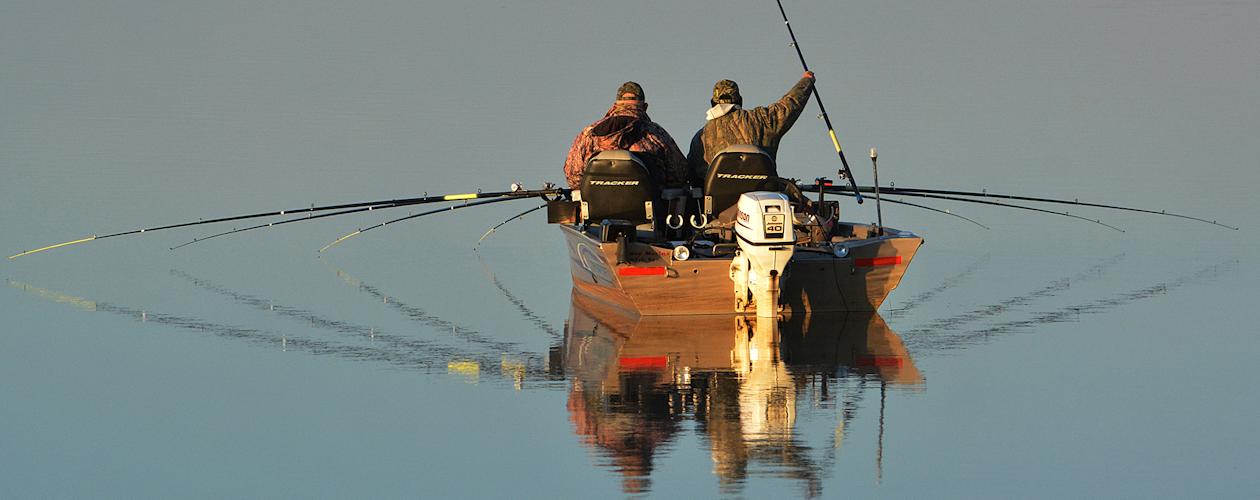Crappie Fishing 101
We have a widely noted population of both White and Black crappie. While many of the same tactics can be used for both species and they are often caught in the same location, there are differences in their typical hang-outs.
Black Crappie
Black crappie are most often found close to rocky shores and around shore-line cover. They also love areas of weedy bottoms. While the bulk of their diet is minnows and other aquatic critters, I've seen them feed on surface insects and the hatching insects like Mayflies or what we commonly refer to as Willow Flies.
Black crappie often provide the earliest action as the spring sun warms up the north shores of rocky bays. Try casting jigs or minnows under a slip bobber, casting curly-tail plastics, or trolling the Roadrunner type spinner heads with plastic trailers for early action as spring arrives. Rocky points can be very good for Black Crappie.
White Crappie
White crappie are usually found in deeper off-shore areas near depth contours and deep cover like stake beds, stumps, and brush. While casting and trolling jigs and plastics has long been a staple of the angler's tactics, most folks think of fishing minnows in any of a variety of ways for White Crappie.
Bouncing bottom weights with double minnow rigs are very popular as the While Crappie start making their way into the bays in early spring. "Spider Rigging" or fishing multiple poles fanned out along the front of one's boat is very productive, using both minnows and plastics on jigs.
Spawning
Both species will leave their winter-time deep water haunts and move shallower, sometimes into ankle-deep water, to spawn. This is the most popular time of the year for crappie fishermen.
There is a mistaken line of thought that the "Crappie Spawn" is an event that last just a few days to maybe a week. This is far from the truth. The crappie will spawn as their preferred water temperature is reached.
The Black Crappie will spawn first, then the White Crappie. The spawning surface water temperatures will vary from the low 60s to high 60s and low 70s. Keep in mind that a 65-degree surface temperature on your marine electronics is much higher than the water temperature at say six feet deep.
With water temperatures moving up and down in a typical spring, the "Crappie Spawn" may last for a month or more in a typical year.
My favorite tactic for both species of crappie is trolling. Early on with surface temperatures from the mid-40s up to the mid-60s, I'll be using a technique we call "Long Lining" or long-line trolling.
This involves casting jigs or roadrunners behind the boat then trolling them slowly through areas we hope hold crappie. Later in the spring through summer, I'll be trolling crankbaits for crappie.
Crappie in the Fall & Winter
As the water temperatures fall in early autumn, the crappie will follow the baitfish back into the bays and toward shallow areas. Many times the crappie will spend the winter in areas close to shallow flats, along contour breaks in cover.
Try casting to cover in bays or spider rigging the flats in water 4-10 feet deep when the surface temperatures get into the 60s and down to the low 50s. Many fishermen will troll longlines with jigs and roadrunners as the water temperatures fall. The key is always finding the baitfish in an area.
Once the surface temperatures get into the 40s and below, the chosen method of most is to spider rig or vertical jig minnows and plastics around cover. Your approach should be as stealthy as possible. If you are using plastics, I highly recommend using an added scent attractant such as Slab Sauce or Crappie Nibbles.
Most female crappie caught in late fall and winter months will contain eggs. While many think this is a sign of a fall spawn, it isn't so. Once crappie finish spawning in the spring and recover, they will immediately start producing eggs for the next spring spawn.
Late fall and winter months are the favorite times for many die-hard fishermen. The boat traffic is less and the crappie fillets will be much firmer and taste better.
One must realize the danger of getting wet in cold water situations and keep extra clothes in the boat. It's best to fish with a partner during cold months.
Editor's Note: Fishing 101: Crappie Fishing is written by professional fishing guide Doug Wynn.








